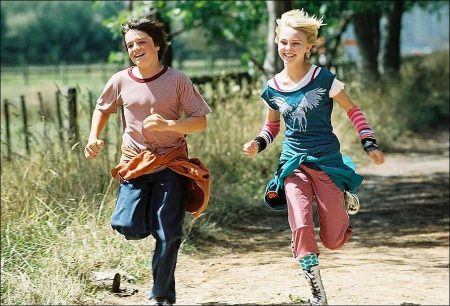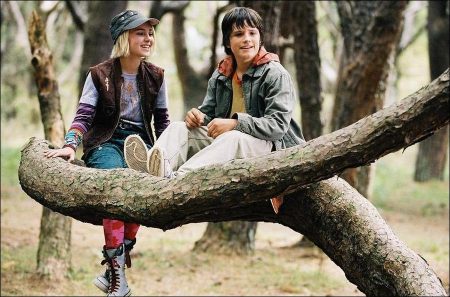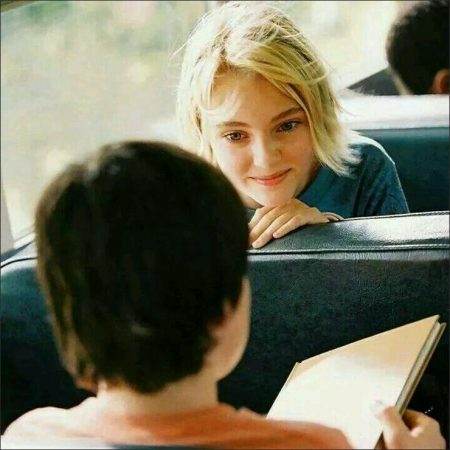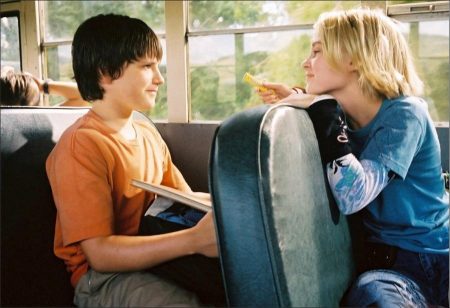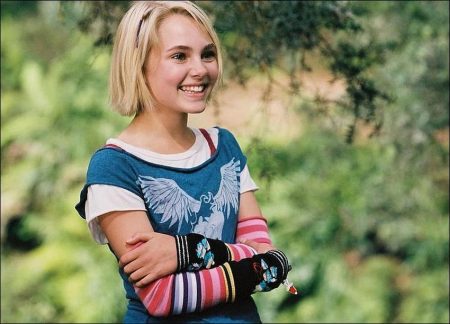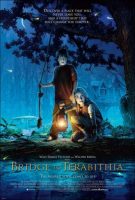Tagline: Just close your eyes and keep your mind wide open.
Deep in the woods, far beyond the road, across a stream, lies a secret world only two people on Earth know about—a world brimming with fantastical creatures, glittering palaces and magical forests. This is Terabithia, where two young friends will discover how to rule their own kingdom, fight the forces of darkness and change their lives forever through the power of the imagination.
From Walt Disney Pictures and Walden Media, the producers of “The Chronicles of Narnia,” and based on one of the most beloved novels of all time, comes an adventurous and moving tale that explores the wonders of friendship, family and fantasy: Bridge to Terabithia.
The story begins with Jess Aarons (Josh Hutcherson), a young outsider on a quest to become the fastest kid in his school. But when the new girl in town, Leslie Burke (AnnaSophia Robb), leaves Jess and everyone else in her dust, Jess’s frustration with her ultimately leads to them becoming fast friends.
At first, it seems Jess and Leslie couldn’t be more different—she’s rich, he’s poor, she’s from the city, he’s from the country—but when Leslie begins to open up the world of imagination to Jess, they find they have something amazing to share: the kingdom of Terabithia, a realm of giants, ogres and other enchanted beings that can only be accessed by boldly swinging across a stream in the woods on a strand of rope.
Here, Leslie and Jess rule as King and Queen among the incredible creatures they create, and not even the forces of evil can break their bond. Now, no matter what happens in the real world, in Terabithia, Leslie gives Jess a magical place that will always be filled with amazing stories and dreams.
Making the Imaginary Real
In the last few years, some of the greatest novels ever written for children and young adults have been transformed into hit movies—from “Holes” and “Charlotte’s Web” to “The Chronicles of Narnia: The Lion, the Witch and the Wardrobe,” and “Because of Winn-Dixie.”
Still, for years, many have wondered if one particular book that has had a most powerful effect on millions growing up in America would ever truly come alive on the screen. This was Bridge to Terabithia, the deeply moving, imagination-sparking tale that stands out because it takes place in a magical kingdom that exists only in the mind’s eye of its two unforgettable main characters, Jess and Leslie.
Though the novel continues to be one of the most significant, widely read and highly acclaimed works of literature for kids, it also laid down considerable creative challenges for any filmmaker: How do you make a film in which the biggest hero is imagination itself? And how could the imaginary world of Terabithia be brought to life on the screen so it would also feel as incredibly real and meaningful as it does to Jess and Leslie?
It would take a labor of love that would begin with the book’s multiple Newbery Awardwinning author, Katherine Paterson. Paterson, considered one of the finest living authors for children and young adults, is thrilled that her story will come to an entirely new generation in a way it hasn’t been experienced before. “Honestly, when I first wrote the novel, I never really knew if anyone whose name wasn’t Paterson would understand it, and I never dreamed it would take on the life, even beyond books, that it has,” she says. “It’s a magical thing that has happened, perhaps because it is the kind of story that opens itself up for people to bring their own lives to it, in a powerful way, so that the story becomes their story.
She is especially pleased with the evocation of the imaginary kingdom of Terabithia. “I admit one of my biggest worries about turning the book into a film was what Terabithia itself would be like. For the past thirty years, readers have been creating Terabithia in their own imaginations, and no two readers will ever have the same vision of the place. I write books because I want the readers’ imaginations to come to life and, although I understand films and books are very different, I hoped that this would somehow be honored in the film. I really don’t understand it myself, but through the writing and the directing and the actors and the designs, beginning with the opening credits, you really feel as if you are walking right into Jess and Leslie’s imaginations—which was a very important thing to me. I really hope it will inspire audiences not only to read books but to see the power of what a story can do, that it can enlarge the human spirit.”
Paterson had originally written the story for her then-11-year-old son, David. Published in 1978, the book soon took on a life of its own, becoming the kind of dog-eared favorite parents would pass along to their own kids and that would be read in schools across the country for years to come. Readers were inspired by Paterson’s story, which she imbued with an unsinkable sense of childhood magic that would inspire millions to believe in the power of the imagination.
Paterson created Terabithia as a place where Jess and Leslie could use their imaginations to deal with the real world—and in the film, they do just that, as each fantastical character in Terabithia has a true-life counterpart. For example, the school bullies who torment Jess and Leslie every day at school reveal themselves as the villains of Terabithia: Gary Fulcher is the Hairy Vulture (part Fulcher, part vulture), Scott Hoager is the Squogre (part squirrel, part ogre, part Hoager) and, of course, the school’s biggest tyrant, Janice Avery, reveals herself in Terabithia as the larger-than-life Giant that they must battle.
Fast-forward ahead and David Paterson was now grown up and, as fate or perhaps destiny would have it, had become a writer himself—an accomplished playwright and rising screenwriter. Having deeply loved his mother’s book for so long, he now became devoted to bringing her vision to the screen with complete authenticity. David had also become a father and so had another incentive—to pass down this rich family legacy of storytelling to his own children.
“I always felt so protective towards this story,” he says. “For me, it was never just about making a movie but about really honoring my mother, the life of the book and my best friend Lisa, who started it all. The most important thing of all to me was to keep the spirit of the book alive while finding a way to transform it from a novel that takes place mostly in the characters’ heads to a dynamic visual medium. But, no matter what, it had to be about friendship and imagination.”
When David went to his mother for her blessings, he found her more than encouraging—she essentially told him to take the ball and run with it. “I knew that David was a fine writer, and I also knew how very much this story meant to him,” says Katherine Paterson. “The story began with him, so I was more than happy to turn it over to him.”
Continues David: “I think she trusted me to do right by the story, just as I had trusted her 30 years ago to tell the story of my friendship with Lisa. Of course, there’s always a lot of angst involved in anything to do with your own mom—but she really gave me complete freedom, understanding that literature is necessarily quite different from film as a medium. And I knew she would have to be pleased with the results, or else holidays would be awfully difficult!”
Meanwhile, producer Lauren Levine had discovered the power of Terabithia on her own. Like many people who first encountered the book as an adult, she found herself swept away by its mix of emotion and enchantment—and she knew it would be a great match for Walden Media, the family-focused production company that has quickly developed a reputation for turning classic children’s literature into equally classic movies.
“Having grown up in the U.K., I hadn’t really known about the book before, but so many people with kids had told me about this story and then, when I read it, wow, I immediately connected with it,” she says. “I love that it’s a story that doesn’t pander to kids. It’s straight up about how life is, but it’s also filled with all these wonderful elements of fantasy and storytelling. It’s really a gift to kids who are facing hard times, and that’s why it has been so loved for so long.”
Levine was inspired to act. “I was so attached to the story that it led me to David Paterson, who, it turns out, had been trying to get a movie made for years,” she says. Walden Media’s CEO, Cary Granat, was just as enthusiastic about the project. “Bridge to Terabithia is the quintessential Walden movie,” Granat says. “Here was a chance to create a great, high-concept film with lots of emotion and, at the same time, to really get the book out there again and explore the many wonderful themes in it as a learning vehicle.”
Also coming on board was producer and former Universal Pictures production president Hal Lieberman (“Around the World in 80 Days,” “Terminator 3”), who was instantly compelled by Jess and Leslie’s story. “Once I read the initial draft of the script, I was in with both feet,” says Lieberman. “It’s the kind of story that is filled with fun and adventure, but your heart is also richer for having experienced it.”
Lieberman was committed to doing the characters and their journey justice: “The idea was to really honor the integrity, the emotion and the fun of the book,” he comments. “Just as in the book, combining the real and the imaginary was what this movie was all about.” David Paterson couldn’t have been more excited with the team that came together behind Bridge to Terabithia. “In a way, I was waiting for Walden Media to be founded!”
David notes. “The wonderful thing about Walden and Disney is that most studios want to completely reinterpret this kind of novel, but Walden and Disney were open to doing a truly faithful adaptation. They wanted to honor the power of the original story.
The adaptation, exciting as it was, posed some immediate challenges. For one thing, the filmmakers were absolutely committed to not altering the story’s very heart and soul. “In moving from the page to the screen, I know choices have to be made,” says Katherine Paterson. “But I think the filmmakers have made good choices. They were able to tell this intimate story of friendship and imagination so that it makes sense visually and dramatically.”
The only major change brought to the guts of the tale was to pull Jess, Leslie and the other characters into the present day to make it more accessible and immediate. Then there was the biggest question of all: how to handle Terabithia? In the novel, the scenes of Terabithia take place in just a few pages of writing that leave the portrait of the kingdom almost entirely up to the reader, sparking their imaginations, as Katherine Paterson had hoped to do. But in the visual realm of film, Terabithia would have to be seen, so it had to be created as a fully fleshed-out world that could come off both as a child’s ultimate wild fantasy and a wondrously real escape for Jess and Leslie.
Says Levine: “We found out that the world of Terabithia was the one thing everyone remembers who read the book as a kid—they all say, ‘Oh, I remember those incredible adventures they had in Terabithia!’ So we wanted to find a way to make that world as vivid and visually exciting as it would be in a kid’s imagination.”
It was important, however, to keep the balance of real life and fantasy in check, and Levine credits editor John Gilbert for that. “John is an amazing storyteller who really knows how to use music, performance and visual effects to great effort. He never let us lose sight of the fact that this is a story about friendship and discovery. His experience working on the huge canvas of ‘Lord of the Rings: The Fellowship of the Ring’ as well as smaller, intimate stories like ‘World’s Fastest Indian’ made him the perfect person to edit this movie.”
David Paterson credits fellow screenwriter Jeff Stockwell (“The Dangerous Lives of Altar Boys”) with giving Terabithia that dose of magic it needed to come to life on a movie screen: a visual framework. “My focus was on bringing out the emotions of the story, but when it came to Terabithia, I really couldn’t go there because it was too close,” says Paterson. “What Jeff was able to do as an outsider who wasn’t so attached to the story was to really let his imagination go free and make up this world in a wonderful way. My mother mentions giants and ogres in Terabithia, but Jeff took her words and created the kind of world that kids create in their dreams. His Terabithia is imaginary but, most importantly, it is also clearly connected to the real world. It’s the place where Jess and Leslie can go to triumph over all the problems of their real lives, together as friends.”
Continue Reading and View the Theatrical Trailer
Bridge to Terabithia (2007)
Directed by: Gabor Csupo
Starring: Josh Hutcherson, Anna Sophia Robb, Zooey Deschanel, Robert Patrick, Bailee Madison, Kate Butler, Emma Fenton, Grace Brannigan, Patricia Aldersley, Lauren Clinton
Screenplay by: David Paterson, Jeff Stockwell, Kevin Wade
Production Design by: Robert Gillies
Cinematography by: Michael Chapman
Film Editing by: John Gilbert
Costume Design by: Barbara Darragh
Set Decoration by: Jackie Gilmore
Art Direction by: Roger Guise, Jennifer Ward
Music by: Aaron Zigman
MPAA Rating: PG for thematic elements including bullying, peril and mild language.
Distributed by: Buena Vista Pictures
Release Date: February 16, 2007
Visits: 108
